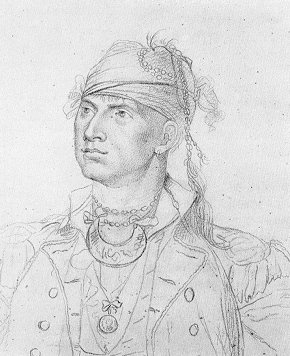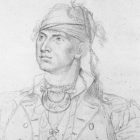Little Prince or Tustunnugee Hopoie: Creek Indian Chief
Little Prince or Tustunnugee Hopoie
Creek Indian Chief

History and tradition are both utterly silent as to the early life of this chief, who lived at Broken Arrow and was for many years speaker of the Lower Creeks. The first notice of him is in 1780. In the spring or summer of this year, the Indian Agent, John Tate, who was stationed at the Hickory Ground, raised a large number of warriors, for the British service from all the Upper Creek towns, except from the Tallassees and the Natchez, and with them marched to the Creek towns on the Chattahoochee.
Here he was reinforced by a band of Lower Creeks under Little Prince. The combined Indian forces, all under the command of Tate, began their march to Augusta to the aid of Colonel Thomas Brown, in command of that post. Near the head springs of Upatoy creek, Tate became deranged, was brought back to Coweta, where he died and was buried. After his death, all the Upper Creeks returned except the Tuckabachees under Efa Tustenuggee, or Davy Cornells. He and Little Prince resumed the march with their warriors, numbering two hundred and fifty, arrived at Augusta and were there when the place was besieged by Colonel Elijah Clarke. In the fighting that ensued, the Creeks lost seventy men, — a loss showing the high grade of their fighting qualities. After the abandonment of the siege and the retreat of the Americans, Colonel Brown first hung some of the most prominent Americans and then delivered the remainder into the hands of the Indians, who, in revenge for their slain warriors, put them to the most torturing and protracted deaths, by cuts, blows, scalpings and burnings.
The memories of Colonels Brown and Grierson, the commanding officers of the post, justly deserve to be held in eternal opprobrium for these enormous atrocities. Those familiar with Indian character and history know that the chief has but little real control over his warriors. What he accomplishes is mainly by dint of persuasion. How much Little Prince favored or disapproved of the actions of his warriors at Augusta cannot be known. But one can indulge in no charitable conjecture in regard to his colleague, Efa Tustenuggee, who is described by General Woodward as being “the most hostile and bitter enemy the white people ever had.”
So far as known, the Augusta campaign was the only military service ever performed by Little Prince. He was one of the signers of the treaty of Coleraine in 1796. He ever after continued friendly to the American government. He was too old for military service during the Creek War of 1813, but was active in sending his warriors into the field. And for his share in the execution of Little Warrior and his party in the spring of 1813, he was one of the seven chiefs formally condemned to death by the war party. He continued to be the head chief of the nation and speaker of the lower towns until his death in 1832. His grave is yet pointed out on Broken Arrow creek.
References. — American State Papers, Indian Affairs, vol. i, pp. 845, 849, 857; Ameri- can State Papers, Indian Affairs, vol. ii, pp. 839, 840; Pickett’s History of Alabama (Owen’s Edition, 1900), pp. 519; Woodward’s Remi- niscences of the Creek or Muscogee Indians, pp. 35, 59; McCrady’s History of South Caro- lina, 1775-1780, pp. 734-739; Jones’ History of Georgia, vol. 2, pp. 455-459.
Additional Information on Tustunnuggee Hopoie has been published by Chris Clark here.
